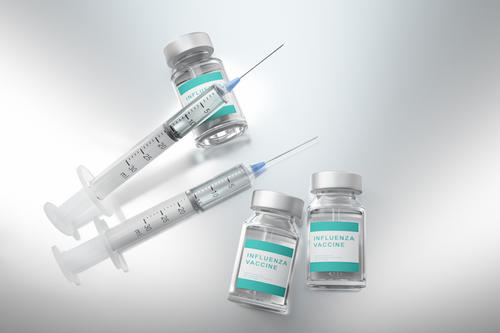With a flu pandemic an ever-present threat, CIDRAP releases Influenza Vaccines R&D Roadmap to improve flu vaccines

The roadmap offers a powerful opportunity to leverage revolutionary advances in vaccine science and technology to better protect against influenza, a disease that could cause a pandemic even worse than COVID-19
The Center for Infectious Disease Research and Policy (CIDRAP) at the University of Minnesota today released an Influenza Vaccines Research and Development (R&D) Roadmap (IVR) to accelerate the development of improved seasonal influenza vaccines and the generation of broadly protective or universal influenza vaccines that could mitigate the impact of future influenza pandemics.
The IVR, produced by an international team of experts, provides a focused blueprint for action that will allow the global influenza community to apply the lessons learned from COVID-19 vaccine development as a springboard for launching a new era for influenza vaccine R&D.
A summary article on the IVR, "A Research and Development (R&D) Roadmap for Influenza Vaccines: Looking Toward the Future," by Kristine A. Moore, MD, MPH, et al, CIDRAP's medical director, (DOI: 10.1016/j.vaccine.2021.08.010) will be published in the journal Vaccine by Elsevier. Copies of this article are available to credentialed journalists upon request; please contact Elsevier's Newsroom at [email protected] or +31 20 485 2719.
Threats from seasonal and pandemic influenza persist in a world still battling the COVID-19 pandemic. As another highly contagious respiratory virus, influenza causes a spectrum of disease, ranging from mild to fatal. Globally, influenza kills up to 650,000 people every year and causes serious illness in some 5 million. In addition to causing respiratory problems, the flu can also significantly increase risks of suffering a heart attack or stroke.
Novel influenza strains also periodically emerge to cause devastating pandemics. According to some models, nearly 33 million people could be killed within the first 6 months of a severe flu pandemic.
“Prior to COVID-19, influenza pandemics were the number one biological risk to humans, and this hasn’t changed,” said Michael Osterholm, PhD, MPH, CIDRAP director and University of Minnesota Regents Professor, McKnight Presidential Endowed Chair in Public Health. “With at least four influenza pandemics in the past century, we know the risk is very real. It’s not if, but when, the next one will occur; therefore, we need to get ahead of this risk instead of constantly playing catch-up.”
For the past 2 years, CIDRAP has coordinated development of the IVR in partnership with the Bill & Melinda Gates Foundation, the Global Funders Consortium for Universal Influenza Vaccine Development (housed within the Task Force for Global Health), the Sabin Vaccine Institute, the World Health Organization, and the Wellcome Trust. This effort, funded by Wellcome, also involved extensive input from an expert taskforce and engagement of more than 100 stakeholder organizations in 29 countries around the globe through extensive discussions, document review, and consensus building.
The impetus to develop the IVR came from the Global Funders Consortium for Universal Influenza Vaccine Development. Consortium deliberations revealed that funding was not the only issue: a lack of coordination among various vaccine research endeavors had become a significant barrier to overcoming the obstacles to influenza vaccine innovation. Consortium leaders concluded that global influenza preparedness required a vaccine R&D roadmap that would provide a clear vision for organizing existing efforts and attracting new partners.
Vaccines are essential for protecting populations from seasonal and pandemic influenza, yet current influenza vaccines and vaccination programs fall short. Current vaccines rely on an outdated, time-consuming technology developed in the 1940s that involves growing vaccine strains in chicken eggs. It requires predicting the dominant influenza strains to include in the vaccine far in advance, and vaccine effectiveness is compromised if those predictions are off-target.
“Rapid development of safe and effective influenza vaccines is critical to fighting influenza, especially given the need for a rapid response to pandemic strains,” said Osterholm. “Every year, seasonal influenza vaccines prevent many deaths and limit the severity of disease in those infected. But current influenza vaccines are nowhere near as effective as they need to be, with overall effectiveness ranging from 10% to 60%.”
According to the developers of the IVR, while important gaps remain in the knowledge of influenza viruses and immune responses, vaccines can be much more effective and production processes much faster. However, to achieve this requires embracing a new level of political commitment, partnerships, and investments—the same combination that accelerated the development of COVID-19 vaccines.
Aimed at scientific and clinical researchers, funders, public health policymakers, industry scientists and business leaders, regulators, and communications/advocacy specialists, the IVR addresses the significant barriers and opportunities for preventing influenza and lays out a 10-year plan to leverage key lessons from the COVID-19 pandemic and reduce the threat of influenza globally through two significant goals:
• Improving the production and effectiveness of strain-specific seasonal influenza vaccines
• Advancing the development, licensure, and manufacture of durable, broadly protective, or universal, influenza vaccines.
The IVR is organized around six key areas of R&D, each of which contains broad goals and specific technical milestones for measuring progress:
• Virology applicable to vaccine development
• Immunology and immune correlates of protection
• Vaccinology for seasonal influenza vaccines
• Vaccinology for broadly protective or universal influenza vaccines
• Animal models and the controlled human influenza virus infection model
• Policy, financing, and regulation
“We have had strong interest and participation in the development of this roadmap from the influenza research community, which speaks to the importance of this effort in accelerating the improvement of influenza vaccines,” added Osterholm.
“Immunization is one of the most effective tools we have to protect against infectious diseases and save lives globally,” said Charlie Weller, PhD, Head of Vaccines at the Wellcome Trust. “With recent scientific advances in the research and development of COVID-19 vaccines, we are now on the precipice of a new era in vaccine development.
“We must now take this opportunity to progress new or improved vaccines that tackle existing health threats such as influenza. The Influenza Vaccines Roadmap is a crucial step on this path and will leverage modern science and technology against this dangerous and disruptive virus.”
-30-
Notes to editors
About the Center for Infectious Disease Research and Policy
CIDRAP is a global leader in addressing public health preparedness and emerging infectious disease response. CIDRAP’s previous research on influenza vaccine R&D includes the Comprehensive Influenza Vaccine Initiative, which resulted in a 2012 report. Founded in 2001, CIDRAP is part of the Office of the Vice President for Research at the University of Minnesota.
About Wellcome
London-based Wellcome supports science to solve the urgent health challenges facing everyone, including discovery research into life, health, and wellbeing, and it takes on three worldwide health challenges: mental health, climate change, and infectious diseases.
- Categories:
- Health
- Infectious diseases
- Population health




